The ships of the Spanish transoceanic emigration
A report on Spanish transoceanic emigration: the ports, the ships, the origins, the destinations, and the odyssey of the emigrants.

The Emigration Law of December 21, 1907, enacted after the permissive Royal Circular Order of September 16, 1853, regulating emigration to the colonies and States of America, defines the emigrants who, especially since 1880, have been the protagonists of the great wave of Spanish migration to America:
"Those Spaniards who intend to leave the homeland, with the paid or free third-class passage, or any other that the Superior Council of Emigration declares equivalent, and with destination to any point in America, Asia or Oceania, shall be considered emigrants for this Law...". This migratory wave would continue with ups and downs until the crisis of 1929, reaching its highest level of departures in the years immediately before the Great War of 1914.
Under the powerful impulse of the misery they wanted to leave behind and the search for welfare for the future, between three and a half and five million Spaniards (mostly "young single men", braceros or day laborers) embarked for overseas from 1882 (the year in which statistical data began to be collected) until 1930. Cuba (benefited by the Law for the Promotion of Emigration to the Antilles of July 1884) and Argentina (an immense territory with scarce labor) were their preferred destinations, followed by Brazil and Uruguay.
In 1880 the migratory fever had already begun. It is evidenced by the setting up, by Royal Decree of the Ministry of Development in 1881, of the Commission to study the means to contain emigration as far as possible using the development of labor. Barely a year later, within the Geographic Institute, the Emigration Bureau was created, which would be in charge of compiling statistics on migratory flows and movements.
Although the deficient counting of flows and clandestine emigration made it difficult to give more accurate data, according to official sources, between 1870 and 1900, 17 million people emigrated from Europe to America. Of these, 1,295,800 left Spain, at an annual average of 43,000 people.
But it was in the years immediately before the First World War that emigration from Spain skyrocketed: in 1910 some 160,000 people left, in 1911 almost 140,000, more than 200,000 in 1912, and around 165,000 in 1913. When the war began, the numbers dropped but a strong migratory flow was maintained (80,000 in 1914, 60,000 in 1915), in contrast with the abrupt fall in the European countries involved in the war, and the numbers rose again in 1920.
This mass emigration was facilitated by advances in the art of navigation (steam replacing sail) and in turn, fostered the development of the shipbuilding industry and the merchant marine. The transatlantic ships and the ports from which they departed were co-protagonists of this social phenomenon, "subject to laws superior to the will of governments" according to Mr. Benot of the Geographical and Statistical Institute in his 1891 report.
After the ephemeral fleet raised by the Marquis de Campo in the 1880s (disappeared at his death in 1889), the most prominent Spanish shipping companies of these migratory decades were the Compañía Trasatlántica Española, based in Barcelona, founded in 1881 by Antonio López y López, Marquis of Comillas, on the iniquitous favor of the government of Sagasta; the Pinillos e Izquierdo and the A. López, of Cádiz; and the Anglo-Bilbao companies: the Ybarra, in Seville, and the Sota y Aznar, in Bilbao.
However, most of the Spanish emigrants to America (around two-thirds of the total) were transported by foreign shipping companies - the Royal Mail Steam Packet Co., Cunard, Compagnie Générale Transatlantique, Societé Generale de Transports Maritimes a Vapeur, Hamburg-Amerika Line and Hamburg-Amerika Line, Hamburg-Amerika Line and Hamburg Sudamerikanische ("the hamburgers"), La Veloce, Lloyd Italiano, Lloyd Austro-Americana, Sociedad Gio, Compagnie Generale de Navigazione Italiana, because their fleets were more modern, their routes more direct and the waiting time for embarkation shorter (La emigración española en América, Fundación Directa).
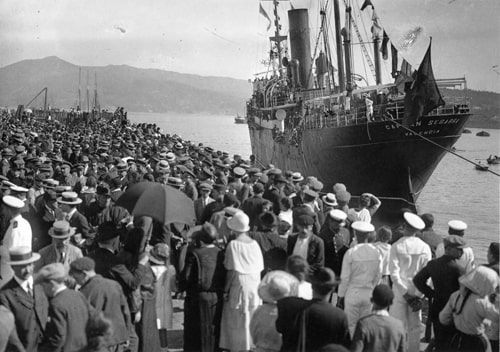
Although the epicenter of the migratory odyssey is located in the long days of sea crossing, characterized by the subhuman conditions of the ships, the filth and stench of the holds, the humidity of the bunks, the infernal noise of the engines, the extreme cold or suffocating heat (depending on the season) and the unhealthy food they received, "the abuses, humiliations, injustices, outrages, and depredations suffered by the migrants, which are the main cause of their suffering, the extreme cold or the suffocating heat (depending on the season) and the unhealthy food they received, "the abuses, humiliations, injustices, outrages, and depredations suffered by the disinherited emigrants" (in the words of the Inspector of Emigration Leopold D'Ozouville) begin before, in the country itself, and end later, when they arrive at their destination.
This realization generated an enormous production of regulations guided by the principle of the protection of Spanish emigrants (1,135 laws and provisions related to emigration were passed between 1907 and 1935, according to González Rothvoss and Gil), which did not serve many purposes, given that their enactment was not accompanied by effective monitoring and control tasks, as if once a problem was legislated it ceased to exist, as Carlos Llorca points out in Los barcos de la emigración (The ships of emigration).
These norms regulated, among other things, the collection of weapons from emigrants, the documentation of single women, the limitation in the payment of freight and transportation expenses to one-third of the emigrant's salary, the transport of live animals and meat, the persecution of clandestine emigration agents, a compensation of two pesetas a day for each day of delay on the date fixed in the ticket for the departure of the ship or the recommendation "to all the people who intend to leave Spain to be very careful when choosing the banks where they deposit their savings" (Circular of November 9, 1929).
After complying with the series of requirements to be able to leave the country, aimed at controlling the departure of single women (or married women without their husband's authorization), and preventing the departure of young men of draft age, the unexpected outlay of money involved in the days of waiting in port until a ship departed was a blow to the economies of people, the vast majority of whom had limited resources and who had already struggled to raise the money to buy tickets that were not at all cheap.
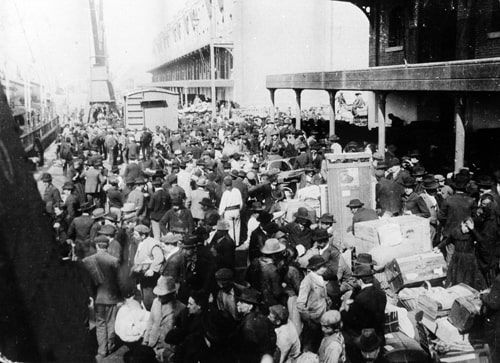
Although the epicenter of the migratory odyssey is located in the long days of sea crossing, characterized by the subhuman conditions of the ships, the filth and stench of the holds, the humidity of the bunks, the infernal noise of the engines, the extreme cold or suffocating heat (depending on the season) and the unhealthy food they received, "the abuses, humiliations, injustices, outrages, and depredations suffered by the migrants, which are the main cause of their suffering, the extreme cold or the suffocating heat (depending on the season) and the unhealthy food they received, "the abuses, humiliations, injustices, outrages, and depredations suffered by the disinherited emigrants" (in the words of the Inspector of Emigration Leopold D'Ozouville) begin before, in the country itself, and end later, when they arrive at their destination.
This realization generated an enormous production of regulations guided by the principle of the protection of Spanish emigrants (1,135 laws and provisions related to emigration were passed between 1907 and 1935, according to González Rothvoss and Gil), which did not serve many purposes, given that their enactment was not accompanied by effective monitoring and control tasks, as if once a problem was legislated it ceased to exist, as Carlos Llorca points out in Los barcos de la emigración (The ships of emigration).
These norms regulated, among other things, the collection of weapons from emigrants, the documentation of single women, the limitation in the payment of freight and transportation expenses to one-third of the emigrant's salary, the transport of live animals and meat, the persecution of clandestine emigration agents, a compensation of two pesetas a day for each day of delay on the date fixed in the ticket for the departure of the ship or the recommendation "to all the people who intend to leave Spain to be very careful when choosing the banks where they deposit their savings" (Circular of November 9, 1929).
After complying with the series of requirements to be able to leave the country, aimed at controlling the departure of single women (or married women without their husband's authorization), and preventing the departure of young men of draft age, the unexpected outlay of money involved in the days of waiting in port until a ship departed was a blow to the economies of people, the vast majority of whom had limited resources and who had already struggled to raise the money to buy tickets that were not at all cheap.
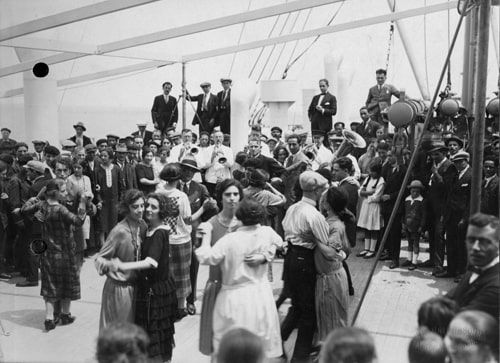
The Inspector begins by exhorting the port's governmental police to search the emigrants and thoroughly examine the hand luggage to avoid subsequent fights on board and recommends that the emigrants themselves leave their "weapons, both firearms, and knives, in Boga's luggage". The meticulous Inspector recommends limiting hold luggage to clothing, linen, and objects for personal and work use, and avoiding the introduction of inflammable and explosive materials, dirty clothes, liquids, and food, "since their decomposition gives rise to the formation of worms that spoil the clothes".
With exquisite rigor, D'Ozouville lists the disadvantages of each part of the ship (bow, a longitudinal axis, foot of the masts, sides or sides, side service corridors, roofing, deck awnings...)
He recommends to the emigrant, "as soon as the ship is unmoored from the dock or weighs anchor to set sail, to take possession of the chosen place with the traveling chair that every emigrant should carry with him...".
He was even warier of those who were not given to hygiene: "If the emigrant washes little, or never washes at all, the bedroom has a bad smell and this becomes unbearable when some lazy person, instead of going to the toilet, pours minor and major waters on the pavement".
As for seasickness, "endemic evil of the voyages, which takes a great variety of forms" and for which he confesses he does not know the remedy, although he points out the convenience of "smoking little or nothing and smelling or eating lemons that the emigrant should carry by hand because they are very scarce on board". If vomiting is unavoidable, in order not to contribute even more to corrupt the atmosphere of the bedroom, the best thing to do is to throw on a handkerchief, "which will be washed immediately", and if the seasick person cannot contain himself, sawdust will be thrown on the floor at once.
He also warns against the abuse of drink and the risk of playing forbidden games, for "rare is the voyage when there are no professional gamblers on board who empty the pockets of the candid as if by enchantment", and reviews the inconveniences inherent in the different ways of entertaining the time spent by fellow passengers (walks, knitting, guitar and singing, dancing, reading, card games,...), and finally proclaims the need to act with indulgence: "Emigrants must not forget that they are all united by the same fate, and onboard, they must consider themselves as true brothers".
Emigration Laws
From the Royal Pragmatic on the license to emigrate of the Kingdom of Philip IV of 1623 to the successive Laws of Emigration or Emigration Regulation issued throughout the twentieth century (1907, 1924, 1960, and 1971), the number of rules regulating the migratory phenomenon is enormous, whether to prohibit it, to regulate it, to assist it or to dignify it.
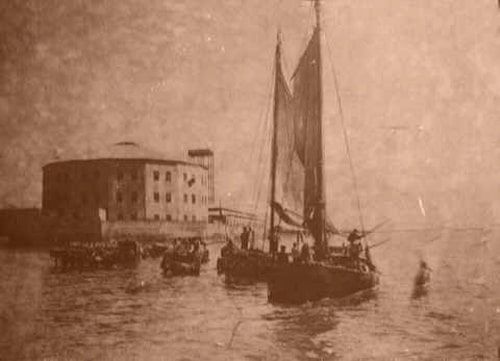
Through this normative production, with titles that move between the dramatic and the picturesque, it is possible to follow the ups and downs of migratory policies in Spain during the last two centuries:
Royal Order that the pension indicated by the regency be continued to those emigrated from America without the need for purification, although those who have obtained subsequent employment in Spain will be subject to it (July 27, 1824).
Royal Order ordering the political chiefs to make those who wish to emigrate to the Republic of Venezuela understand the work and penalties to which they will be subjected (May 21, 1847).
Royal Order of the Ministry of the Navy on the provision of a surgeon and chaplain for ships going overseas (March 27, 1848).
Royal Circular Order of 16 September 1853 regulating emigration to the colonies and States of America.
Royal Order dictating rules to contain the emigration of young people abroad and overseas without having suffered their fate in the quintas (July 17, 1861).
A law establishing rules regarding the nationality of the children of Spaniards born in the American republics (June 20, 1864).
Royal Decree of the Ministry of Development, creating a Commission to study the means to contain emigration (July 18, 1881).
Royal Order of the Interior with rules for embarkation to America (November 10, 1883).
Article 14 states: "Care will be taken to ensure that emigrants do not obligate the totality of their salary for the payment of freight and transportation expenses, allowing them to do so only for one-third of their salary".
Law for the promotion of emigration to the Antilles (July 1884).
Royal Order on embarkation (September 21, 1894).
Royal Order to avoid the emigration of those obliged to the service of arms (January 25, 1897).
Royal Order that the young men who are going to reside abroad before being free of conscription must deposit 1,500 pesetas (May 8, 1900).
Emigration Law (December 21, 1907).
Royal Order on the transport of live animals and meat on emigrant ships (November 10, 1908).
Circular on a collection of arms from emigrants (February 28, 1913).
Agreement on documentation of unmarried women (November 14, 1913).
Royal Order of Fomento limiting, for sanitary reasons, the embarkation of emigrants (March 29, 1920).
Emigration Law (December 20, 1924).
Royal Order on the persecution of clandestine emigration agents (April 26, 1926).
Circular that it is recommended to all the people who intend to leave Spain to be very careful when choosing the banks where they deposit their savings (November 9, 1929).
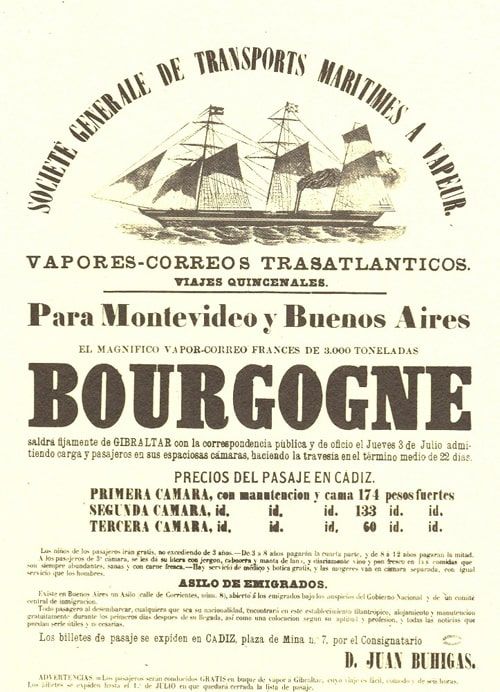
This enormous normative production aimed at protecting the interests of Spanish emigrants (1,135 laws and provisions related to emigration were passed between 1907 and 1935, according to González Rothvoss and Gil) did not serve many purposes, since their enactment was not accompanied by effective monitoring and control tasks, as if once a problem was legislated it ceased to exist.
By J. Rodher




